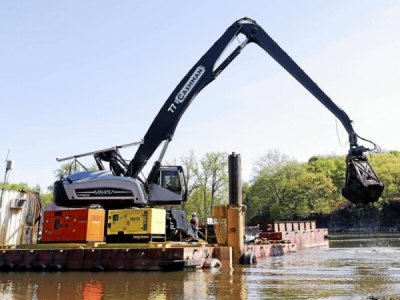
Posted on May 17, 2019
SARATOGA SPRINGS, N.Y. — General Electric Company’s Hudson River PCB cleanup work is far from done despite spending $1.7 billion on a six-year dredging project, officials say.
Recently, the U.S. Environmental Protection Agency ruled that the job was carried out as called for under a court order.
But a final “Certification of Completion” won’t be issued until the EPA is convinced that dredging has achieved its goal of protecting human health and safety, and the environment, which might take several decades as the river’s natural recovery occurs.
“GE is still very much on the hook,” EPA Regional Administrator Peter Lopez said Tuesday, during a Citizens Advisory Group meeting at the Gideon Putnam Hotel. “GE’s next obligation is to monitor the river and the dredging areas and to see if in fact, the remedy is performing. We need to make sure the fish are getting better and as we do sediment samples that everything they did is leading to a final end state of protectiveness.”
“If in fact, we feel the remedy is not protective, we have the opportunity and responsibility to reassess it and then determine what GE’s role is in putting us back on track,” Lopez said.
Environmental groups such as Scenic Hudson and Riverkeeper have blasted EPA for saying dredging was done correctly, while at the same time acknowledging it hasn’t met its goal of protecting human health and the environment.
Previously, the state Department of Environmental Conservation also said dredging didn’t go far enough and that some critical pockets of PCBs were left behind.
GE discharged an estimated 1.3 million pounds of polychlorinated biphenyls (PCBs), a suspected carcinogen, into the river from plants in Hudson Falls and Fort Edward over a more than 30-year period ending in 1977.
Dredging removed 2.65 million cubic yards of contaminated sediment from a 40-mile stretch of river, from Fort Edward south to the Troy Dam. The work lasted from 2009 to 2015.
EPA says the main way to determine dredging’s effectiveness is testing PCB levels in various species of fish, taken from numerous locations. However, conclusive data might not be known for many years.
Meanwhile, many people are also concerned about the threat of PCBs in the floodplain surrounding the river, and in the Lower Hudson’s waters from Troy all the way to New York City.
About 8,000 floodplain samples have already been taken, and property owners are being advised of such results. But it will likely take another five years before a formal decision is made that determines how GE does this cleanup, too, said Gary Klawinski, EPA Hudson River Project manager.
Julia Stokes, of Schuylerville Area Chamber of Commerce, said many local residents’ property values are being negatively impacted while waiting for remediation to occur.
“How long is it going to be before you take care of it so we aren’t looking at it every year?” she said.
Advisory Group member David Mathis, of Schuylerville, raised concerns about young children wading in the water, in potentially contaminated soil.
“We wait and wait and wait,” he said. “It doesn’t help our kids. We need to get areas tested and at least put a sign up saying, this area is contaminated or this area is safe.”
EPA Deputy Regional Administrator Walter Mugdan said heavily used places such as Fort Hardy Park have been tested and are safe. New samples are taken each time there’s a high-water event such as recent spring flooding, to make sure PCBs aren’t present, he said.
In addition to testing fish and sediment for PCBs, a variety of other post-dredging activities are also taking place, such as monitoring restored habitat and caps covering hard-to-reach PCBs, which dredging couldn’t remove.
“So GE’s not going anywhere,” Lopez said.
Source: saratogian.com





